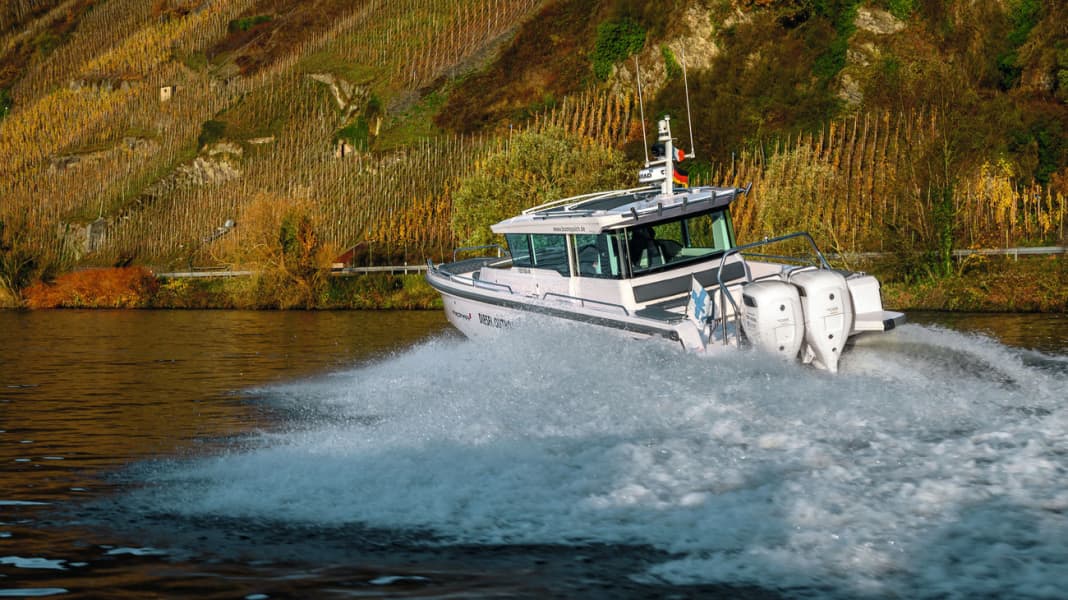
Over the past few decades, there have been repeated attempts to combine the economic properties of the diesel engine with the advantages of an outboard motor. Especially for commercial use, as a tender or for naval boats, such a diesel outboard would be a great asset. In the 1980s, Yanmar managed to fill a niche for a short time with a series of outboards (D 18, 27, 36, 40)."The only choice in diesel outboards",the manufacturer wrote on the advertising
advertising brochures. However, the engines did not catch on. Admittedly, they were a little too early on the market. Back then, nobody could have foreseen the outboard hype that is now dominating the boat market and producing more outboard boats than ever before.
But why should you put a diesel outboard motor on your boat? For whom is such an engine suitable, and what are its strengths?
The advantages of the outboard engine are simple installation and replacement, cost-effective and simple maintenance, more space below deck. The diesel engine has a longer service life than the petrol engine, more torque and it consumes less fuel. Especially when used as an engine for tender boats on mega yachts or in very remote areas, there is also the advantage that diesel fuel is easily available everywhere.
Almost 30 years after Yanmar, Neander Motors from Kiel (in cooperation with Yanmar) landed a direct hit with its 50 hp D-Torque 111: an engine that fits perfectly on RIBs and workboats in terms of size, has almost twice as much torque as comparable petrol engines (111 Nm) and has good handling characteristics (BOOTE 1/18). However, with a price tag of around 42,000 euros, it is prohibitively expensive for private individuals and simply too sluggish for the tender boats of mega yachts.
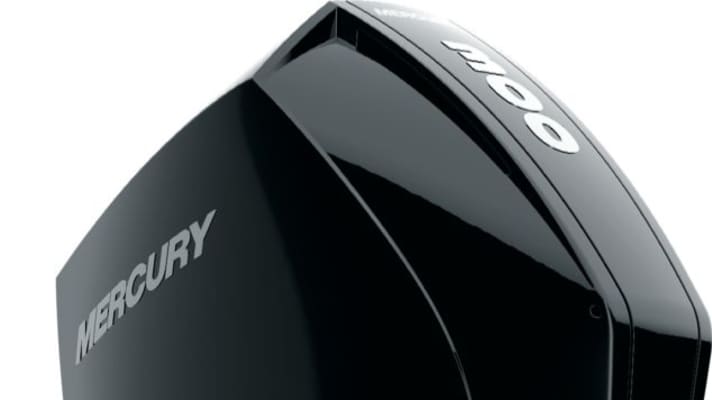
This is why the entire water sports industry has been following the development of the new diesel outboard from Cox-Powertrain in England with great interest for years. A promising engine, well dimensioned as an 8-cylinder with 300 hp - and unlike the equally powerful OXE from Sweden, which was partly marinised from the automotive sector, the CXO300 was developed on the drawing board specifically for its intended purpose.
That's why we couldn't wait to try out an Axopar 37 with two Cox diesels at Boote Polch on the Moselle and compare it with the identical boat that we had driven the year before with Mercury Verado F300 engines. Does the engine live up to the favourite argument of all diesel enthusiasts - the significantly lower fuel consumption? How do the driving performance and speed change?
The test boat
- Shipyard: Axopar Boats/Finland
- Type: 37 XC Cross Cabin
- CE category: B/10 persons
- Hull and deck: plastic
- Overall length: 11.50 m
- Width: 3.35 m
- Weight (without outboard): 3770 kg
- Draught: 0.85 m
- Clearance height: 2.80 m
- Fuel tank: 730 litres
- Water tank: 100 litres
- Holding tank:70 litres
- Berths: 2 + 2
- Freeboard: 0.45 m
- Max. motorisation: 2 x outboard engines, 257 kW (350 hp)
- Test engine petrol: 2 x Mercury V8, 221 kW (300 hp)
- Test engine diesel: 2 x Cox V8, 221 kW (300 PS)
- Price (standard boat with Mercury) 222 369 euros
- Price (standard boat with cox): 315811 Euro
- Distribution (test boat): Boote Polch KG, D-56841 Traben-Trabach, www.bootepolch.de
The fuel consumption will only be revealed in the measurements. However, we can already get a first impression of the differences to the petrol engine when manoeuvring: The maximum torque of 650 Nm at the crankshaft and more than 800 Nm at the propeller shaft (with a gear ratio of 1.46 : 1) is a strength of the Cox diesel, as it allows the boat to be steered even with the engines. One engine forwards, one backwards, and the Axopar starts to turn. Unimaginable with a petrol engine. But what other advantages does the higher torque have?
An old mechanic's adage says that the power of the engine determines the speed at which you hit a wall. Torque, however, determines how far you take that wall with you. Black mechanic's humour, but the proverb clearly shows what the biggest difference between the Cox and the Mercury is: both engines are very similar in terms of top speed at 48.8 (Mercury) and 47 knots (Cox). Both produce 300 hp. But when we take a bend on the narrow Moselle at full speed with the diesel, the diesel outboard pushes the boat hard thanks to its strong torque, and at the end of the turn we have only lost 4 knots. The petrol engine loses a good three times as much speed during such manoeuvres. It would be very interesting to find out exactly how big the difference in torque is, but Mercury was unwilling to provide a torque curve when asked by BOOTE.
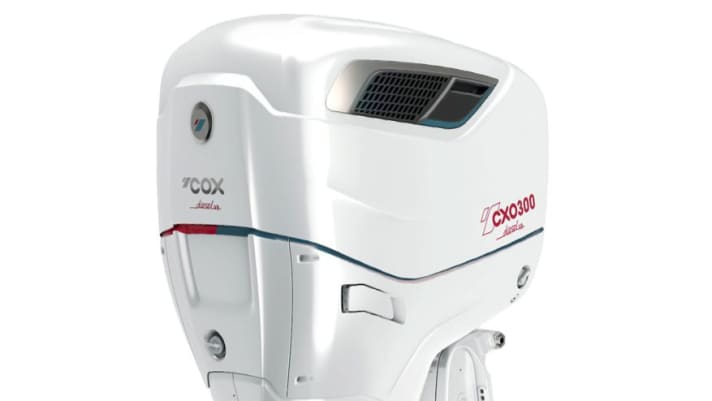
Applied to the proverb, the comparison teaches us: on the straight, both engines with the same power are similarly fast, but thanks to the high torque of the diesel, the boat with the Cox engines almost maintains its speed even after the tight bend.
But what about fuel consumption? Of course, the Cox diesels are also somewhat more fuel-efficient than the petrol engines. At an economical cruising speed of around 23 knots, the diesel (2500 rpm) requires only 2.4 litres per nautical mile, measured for both engines. The Mercury, on the other hand, requires 2.57 litres (at 3500 rpm). A range of 242 nautical miles for the petrol engine, while the diesel goes 17 nautical miles further. At full speed, the diesel requires 3.07 litres per nautical mile at 4000 rpm and 47 knots, while the Mercury requires a full 3.66 litres per nautical mile at 6000 rpm and 48.8 knots, which means it is 32 nautical miles shorter.
which gives it a range that is 32 nautical miles shorter. However, this comparatively low fuel saving of the diesel compared to the petrol engine does not necessarily mean that the former is hardly more economical. In last year's test of the Axopar 37 with the two Verado models, we already noticed very favourably how economically the engines and boat work together.
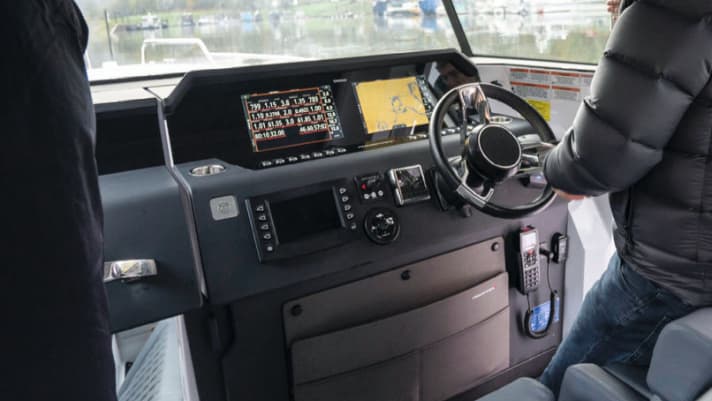
If you consider that a Cox is almost twice as expensive at around 68,700 euros as a Verado F300 at around 35,900 euros, then you can't really use the fuel savings as a selling point anyway, except for the three times longer service life of the diesel according to the manufacturer. After all, it would be less sustainable to burn two Verados in the same time.
It is difficult to directly compare the driving performance of the two engines because both naturally have some advantages and disadvantages typical of diesel and petrol engines. Of course, the agility of the diesel is particularly impressive, whereas the petrol engine really gets going when you kick it down, as is typical of diesels. Both Cox models are also significantly louder than the Verado when cruising.
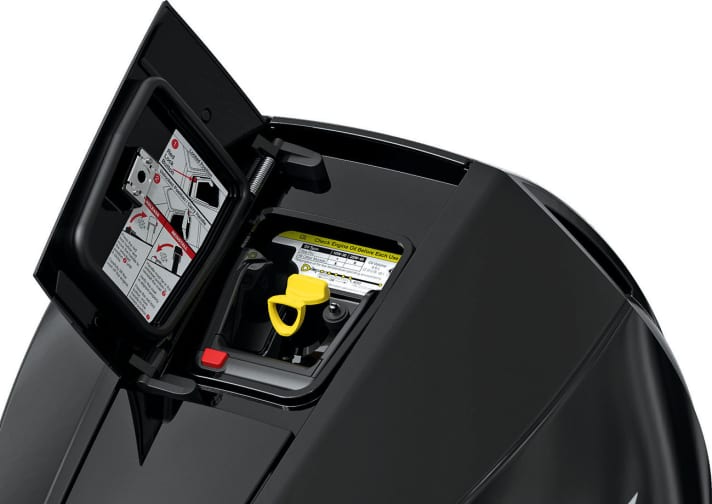
"When it comes to handling characteristics and performance, the Cox outboards would probably have to be compared with an identical boat with an inboard," says Patric Polch, who, as a German dealer for Axopar and Cox, is showing us his boat. For him, the combination of Cox and Axopar represents a good symbiosis: "The Axopar hulls are built less for looks and more for function and handling characteristics," he explains, adding: "With the two Cox outboards, this is even more effective than it already is." During test runs, he even managed to keep the boat cruising at 30 knots with a fuel consumption of 2.1 litres per nautical mile. The comparison with the petrol engine is really significant.
But Patric Polch also wants to show us another of his strengths. He switches off one engine, trims it up completely until the drive comes out of the water and accelerates the other engine until the rev counter reads around 3000 rpm. "Do you notice anything?" he asks us after a moment. Now we recognise it ourselves. "It's crazy, we're gliding. With just one engine." The log shows a speed of 16 knots. Really impressive.
Need more information? The outboard motor test "Diesel versus petrol" can be found with further pictures and measurement results in BOOTE issue 03/2022 - since 16 February 2022 at newsstands or online in the Delius Klasing shop Delius Klasing Shop.

